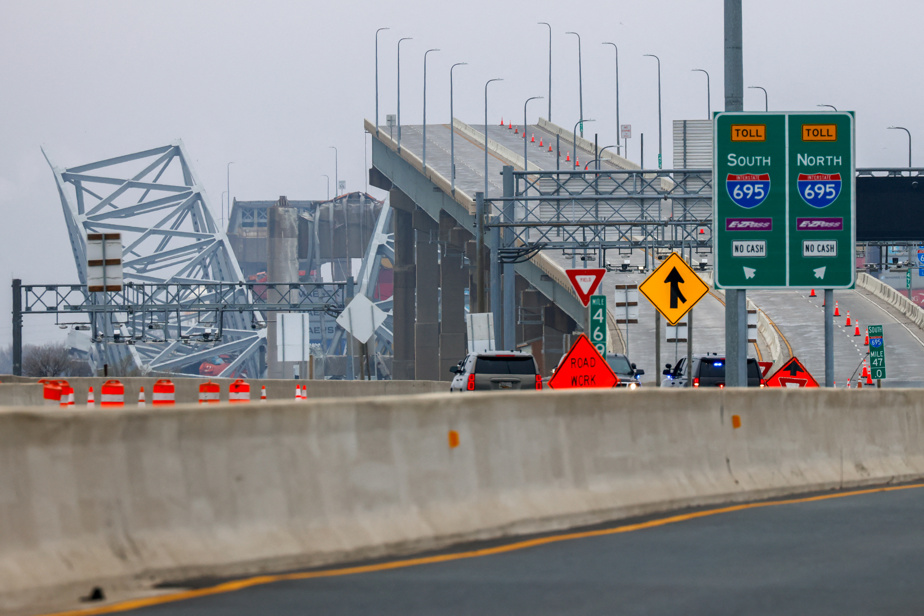(New York) The closure of the port of Baltimore, inaccessible for an indefinite period since the spectacular collapse of a bridge hit by a container ship on Monday, should have a limited effect on the United States economy thanks to the capacity of reception of port infrastructures on the East Coast.
“There will be disruptions in the supply chain but I don’t think there will be a macroeconomic effect because there are so many major ports very close to Baltimore,” Ryan Sweet told AFP , chief economist at Oxford Economics.
He does not anticipate a “large supply shock” that would affect inflation and U.S. gross domestic product (GDP).
And car manufacturers, who particularly use this port, “have higher stocks than a few years ago”.
“As for many manufacturers, the port of Baltimore is a crucial part of Mazda’s logistics chain in the United States,” noted the Japanese group, specifying that it is “in the process of assessing the potential impacts of a prolonged closure” .
“At this point, we have not finalized an alternative plan,” he added.
According to the Bloomberg agency, Mazda was the largest automobile importer in Baltimore, in value, in March, far ahead of German Mercedes and Japanese Subaru.
The American Ford clarified Tuesday morning that when modifications were necessary, “our teams have already provided maritime alternatives”.
Its competitor Stellantis (Jeep, Chrysler, Fiat, etc.) is discussing with its “various transport suppliers regarding alternative solutions to guarantee an interrupted flow of vehicles to our customers”.
Transport Minister Pete Buttigieg nevertheless spoke of a “major and prolonged impact on supply chains”.
The Danish shipping giant Maersk – also charterer of the MV Dali which hit the Francis Scott Key motorway bridge – warned its customers that cargo ships would be unloaded in other ports, which could cause delays.
New York “ready”
The Port of New York-New Jersey (NYNJ), about two days’ sailing north of Baltimore, “stands ready” to provide any assistance needed and “to ensure the continuity of the supply chain along the coast East,” said Bethann Rooney, its director in a press release.
According to an industry expert, this port receives as many containers in a month and a half as Baltimore does in a year. And it has available capacity because it currently handles 20% fewer containers than in 2021.
Additionally, “most ships that go to Baltimore stop first at New York-New Jersey. It’s like a bus line, with stops all along the coast, he explains to AFP, specifying that the Dali made a stopover at NY-NJ around March 19.
“It will not really be about additional ships but more cargo unloaded,” continues this source, noting that already 60% to 70% of cargo is unloaded from NY-NJ due to the density of the population.
According to the Pacific Shipping Association (PMSA), Baltimore handled 1.12 million 20-foot equivalent containers (TEU, industry measure) in 2023, placing it thirteenth in North America.
According to this ranking, the port of NY-NJ is in third position with 7.81 million TEUs.
It is Baltimore and, more broadly, the state of Maryland, which should suffer the most from the closure of the port and the destruction of the bridge located on a major axis.
State Governor Wes Moore highlighted on CNN the “economic importance” of the port where approximately 51 million tons of international goods arrive.
The port’s website states that it generates nearly $3.3 billion in wages, directly employs approximately 15,000 people and indirectly supports nearly 140,000 jobs.
It is served by around fifty maritime carriers, making some 1800 visits per year.
It claims to have managed, in 2023, the most vehicle shipments (847,158 automobiles and light vehicles) of all American ports – for the 13e consecutive year – as well as agricultural and construction equipment, sugar and plaster imports. It was second in coal exports and, in 2022, sixth in coffee.
The Patapsco River, which the Key Bridge spans, is also frequented by cruise ships.
The shipping company Carnival Cruise has returned to the port of Norfolk (Virginia) and American Cruise Lines, which operates this season from the federal capital Washington, will make “the necessary adjustments” for its circuits scheduled to begin in May from Baltimore.
